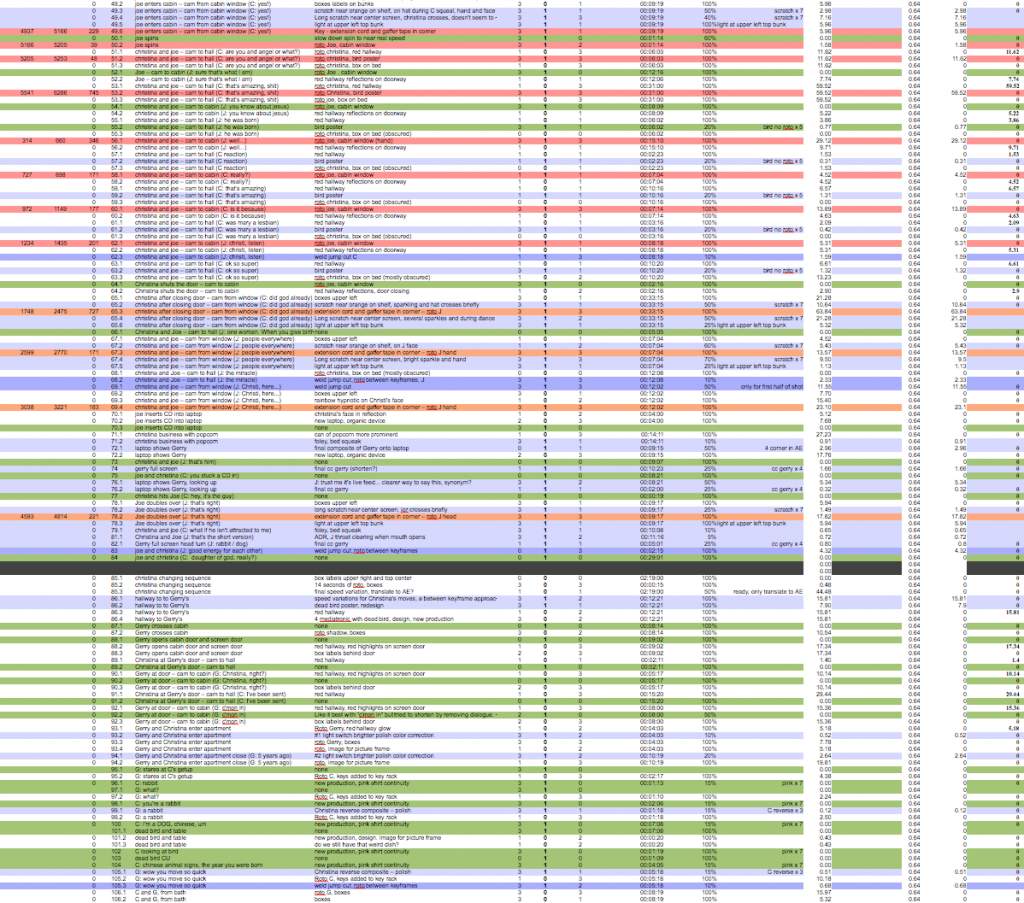04/29
Wow! In assembling the definitive essentials, I am finding more bits of fat to trim away… incredible!
Beyond essentials, if we do flashbacks perhaps Uncle Joe could be making Christina tea when she comes in with the PKD book. Here’s your tea Christi… then cut to CU of him reading.
05/06
The edit has settled. I may yet be surprised but I believe DOG has achieved optimal editorial svelte.
Last Sunday I was preparing to launch the next wave of contractor tasks, today I think I’m finally ready. After finding more ways to trim both acts, I re-exported all the reference movies, rebuilt the AE task comps, created sample images and then rebuilt the projection spreadsheet. It’s still predicting a wad of work ahead, but the calculations are still sloppy.
Duplicated work is not taken into account, eg the same change is needed over several shots. Once the solution is created in one shot, the associated layers can be duplicated as needed.
Percentage = the duration of the change / the total duration of the shot. If keywords could be searched in the task description, then the spreadsheet could adjust all duplicated percentages. For 5 duplicate tasks, the percentage would be 20% for each task. Another approach would be to find the first iteration of the task and then make the percentages for all the duplicates 0%.
A wider spread for the complexity value is needed. In the above scenario, even if all duplicate percentages were set to 0% via scripts or macros, the percentage for the first duplicate task ought to be valid. A very simple change happening over the entire shot would always be 100% but this tends to skew the completion calculation to the high end, especially for long shots. Rather than kludge the design and try and lower the percentage, having a value for negligible complexity would be good, maybe 1-5 rather than 1-3. 1 and 5 would be extreme values and rarely used, except in such special case scenarios. The base hours per second could then be lowered so that a future complexity value of 2 is equal to 1, so maybe 1 through 5 would be correspond to .1x, 1x, 2x, 4x and 8x.
Recent trimming of both acts is not yet reflected except for the tasks being contracted.
I’ve added some tasks like rotating skewed compositions in Act 2 and roto welds as discussed on April 21. Though this has added to the completion time, I’d guess the current estimate is 30% too high. I’d like to add the macro functionality described, but I don’t want to get sidetracked refining the projection tool. There’s likely another 5 weeks left for Essentials. When Essentials are complete and assembled, I’ll look into beefing up the spreadsheet before making a final decision about implementing the rest of the project.
I’m leaning toward doing the boxes and red hallway, but it’s very valuable to work within the limits defined by Essentials, especially since I’ve sliced out such major chunks as the flashbacks, changing sequence and surveillance.
So here’s an excerpt of the projection with color coding. Light and dark purple represent tasks that I plan on doing, pink and orange are ready for contractor bids, green is completed or no change, white is non essentials and dark grey is an act divider.
